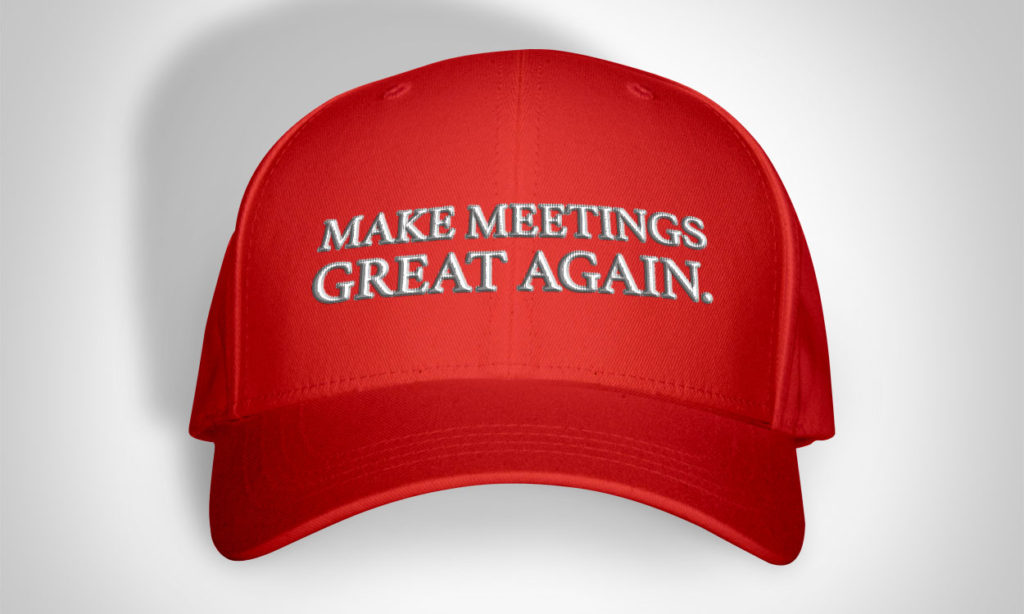
It’s amazing how many unproductive meetings we have to suffer through at work; meetings about meetings, meetings that run thirty minutes over their allocated time, meetings people don’t show up for, or the dreaded “we forgot to book a meeting room so let’s run around the office for 15 minutes before we begin” meetings. It’s never the intention to waste our precious time by pulling us away from GETTING S**T DONE but even so, it happens. Consistently.
Meetings are important communication tools in any organisation; when set up and organised correctly they can help solve complex challenges quickly by bringing the right people together. The challenge is in making sure they’re productive and born out of necessity, not just a meeting for a meeting’s sake. If you’ve found yourself or your team approaching meetings with despair and would like your get-togethers to be more productive, you need to be clearer about what you want and expect from each one. Set high standards and lead by example. Follow these simple rules.
1. What’s the point?
What do you hope to get out of the meeting? Be outcome focussed. Make it concrete. The objective isn’t to “discuss something”, it’s to create a plan, or agree next steps. Having a clear objective will keep you focussed on making productive use of your time. If there’s no outcome, a meeting probably isn’t required.
2. No agenda. No meeting.
Make sure every meeting you arrange has an agenda. Get into the habit of asking the organiser for an agenda before you accept an invite. If the agenda isn’t clear, the chances are the meeting isn’t necessary and will be a waste of time. Investing time in developing the agenda ensures the meeting has a clear purpose and the organiser is invested in making sure it goes ahead and is productive. It also gives everyone a chance to see if they are actually required. If the agenda doesn’t relate to you, you may suggest that you’re not needed and can send someone else who is.
3. Divide and conquer.
Assigning meeting roles and ownership of agenda points will make meetings more productive. Sitting around a table wondering who’s going to start is both awkward and infuriating when you have deadlines waiting for you back at your desk. When organising a meeting, be clear about who owns each agenda item. Accountability sets expectations. People will come prepared for their section and the meeting in turn will be much more productive.
4. Stick to your lane.
No one likes to be thrown out of the meeting room in the middle of a discussion because Bob only allocated 30 minutes to a meeting about next year’s growth strategy – come on Bob! Break it down, assign time to each agenda point and if a section begins to run over, agree to pick it up as a follow-up action point. Not only will this help you estimate how long the meeting will take, it helps the meeting organiser keep track of time to ensure everything is covered efficiently. Make sure to assign time for introductions and breaks if required.
5. Take prep seriously.
Does anything shatter your soul more than the “I haven’t read any of the documents – can we spend the first 20 minutes going through these?” statement at the beginning of a meeting? There was no time assigned to that and now we’re suddenly 20 minutes behind schedule. If this happens, the answer needs to be no. Of course, other deadlines and projects get in the way (especially with internal meetings that never seem to get prioritised) but we need to make sure we’re respecting our own and our colleague’s time.
6. Be ruthless about time.
If a meeting starts at 10am, that doesn’t mean leaving your desk at 10am to head to the meeting room. Be seated in the room by 10am, ready to begin. Start on time and don’t wait for anyone. This will help reiterate the importance of being on time and will send the right message to people to take meetings more seriously.
7. No tangents allowed.
Although admirable, our passion for certain topics can take us off course; a conversation about staff morale leading to a long and spiralling conversation about the political climate and why we never seem to get things done can be both exhausting and completely unnecessary. Call tangents out. If someone goes off topic, tell them and agree to pick it up again over coffee or in another meeting if necessary. Tangents waste time and distract from the point of the meeting.
What’s more, encourage people to be positive and productive in their feedback. The beauty of ideas is that bad ones will die of their own accord without needing to actively torpedo them, as long as the focus is on building and developing the good ones.
8. Decide what to do next.
Then do it. Throughout the meeting, take notes of any items that require actions or a follow up. A little tip I learned is to create a code in your notebook. I use the following:
- A checkbox for any actions for me (so I can tick when done).
- A star for items I need to read up on or discuss further with someone.
- A circle with initials for any other attendees’ actions.
This way at the end of the meeting I can go through my notes and quickly summarise next steps for everyone. I always assign 5 minutes at the end of every meeting to summarise and ensure that all actions are recorded. I then follow up in an email assigning an owner to each action.
9. Be at one with the meeting (and turn your phones off).
Nothing halts a meeting’s progress more than someone leaving to take a call or getting distracted by sending an email. Even worse, the person who’s agreed to be in two meetings at once and is planning to leave half way through. When you accept a meeting, you’re making a promise to be there and be engaged. Be in the room and participate. If you’re input isn’t required, you shouldn’t be there. If something urgent is happening outside, explain to the meeting organiser that you may need to leave at some point and ask if that will be an issue.
10. Bonus Level: Record a meeting score.
This is the holy grail of meeting rules and provides the opportunity to hold yourself and attendees accountable to hosting and attending productive meetings. At the end of the meeting ask each person to score it out of 10. A point should be deducted for any principle broken. “I’m giving it an 8 because there was no agenda and someone left to take a call”. Two points deducted! Take a score average and feed this back to the team. We should always be aiming for level 10 meetings! If meetings are unproductive and waste time they shouldn’t be happening.
These rules are both for meeting organisers and attendees. To really make an impact with them, everyone needs to agree to follow them and to hold one another accountable. Each member of the team has the right to challenge a meeting they feel may not be necessary. For those Meeting Mavericks that are as geeky about this as I am, I’ve also included an example meeting agenda below to help you get started!
AGENDA TEMPLATE
Meeting location: [Address and room]
Objective: Agree next steps / actions / strategic approach for x, y, z.
In the room: [Name - Job Title]
Agenda:
- Introductions (5 mins) – All
- Meeting purpose (5 mins) – meeting organiser
- Discussion point 1 (10 minutes) – team member
- Discussion point 2 (10 minutes) – team member
- Q&A (15 mins) – All
- AOB (5 mins) - All
- Summary, actions and meeting score (5 mins) – meeting organiser
Prep work:
- Review agenda and feed back to meeting organiser with any changes / additions.
- Read attached documentation (X, Y and Z).
- Share meeting slides by [Date]
- Prepare questions.




